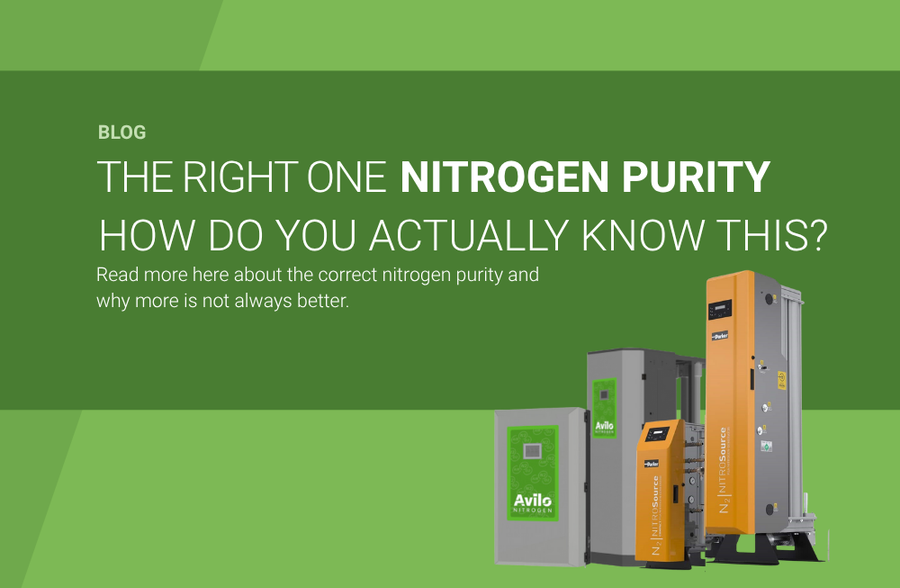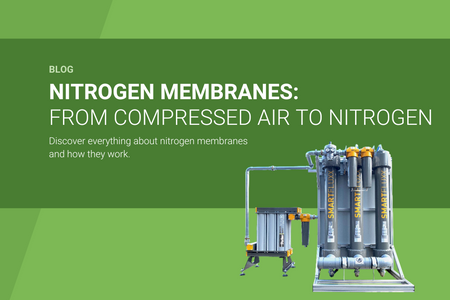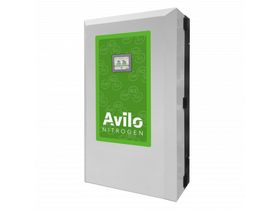
At Avilo, everything revolves around precision. Whether it concerns the supply of nitrogen for industrial processes or the precise adjustment of nitrogen purity, every detail matters. Yet many companies believe that the highest purity is always the best choice. In reality, it’s not about the highest value, but about the right nitrogen purity. In this blog, you’ll read how different purity levels work in practice, which techniques are used, and what that means for efficiency and quality.
What does nitrogen purity actually mean?
When we talk about nitrogen purity, we refer to the ratio between nitrogen (N₂) and other gases, usually oxygen. Simply put, the higher the nitrogen purity, the less oxygen remains in the gas.
To make that a bit more concrete: at a nitrogen purity of 99.999%, only 0.001% residual oxygen remains. That’s truly minimal. This immediately shows what a high purity level means in practice.
However, such an extremely high nitrogen purity is often not necessary. For most applications, a slightly lower percentage is more than sufficient to work reliably, safely, and efficiently.
The right nitrogen purity fully depends on the process:
- For high-temperature processes such as laser cutting or annealing, a high nitrogen purity is required to prevent oxidation.
- For inert blanketing, covering liquids or silos to prevent fire or explosion, a nitrogen purity of 95–98% is usually more than sufficient.
A higher nitrogen purity in that case provides no additional benefit—only higher costs.
Efficient production with the right nitrogen purity
A major advantage of on-site nitrogen generation is that you can determine the exact purity level you need yourself. With Avilo’s nitrogen generators, you can precisely set the desired purity level, tailored to your application.
This is not only practical but also sustainable and cost-efficient. At lower nitrogen purity levels, less compressed air is required, which means the system consumes less energy. Even a slightly lower purity can make a significant difference in consumption and efficiency, without compromising process quality.
PSA vs. membrane technology
Two main technologies are used for nitrogen production: membrane technology and PSA (Pressure Swing Adsorption) technology.
The membrane technology is ideal for applications where a nitrogen purity of up to around 99.6% is sufficient. Compressed air is passed through a special polymer membrane that selectively allows oxygen and other gases to pass through while retaining nitrogen. This method is energy-efficient, low-maintenance, and provides a continuous nitrogen flow. It’s an excellent choice for applications such as:
- Food packaging (MAP packaging)
- Blanketing in chemical or pharmaceutical processes
- Protecting silos and tanks against oxidation or fire hazards
PSA technology comes into play when a nitrogen purity higher than 99.6% is required. This method uses adsorbents (Carbon Molecular Sieves) that temporarily capture oxygen molecules while allowing nitrogen to pass through. When the pressure changes, the oxygen is released and the cycle repeats. PSA systems provide nitrogen with high purity and consistent quality, which is essential for:
- Laser cutting and metal processing
- Pharmaceutical production
- The electronics industry
- Process environments where even minimal oxygen residue is undesirable
In practice, membrane technology is the most efficient choice for medium nitrogen purities, while PSA technology is the right solution for critical processes that require maximum purity and stability.
How is nitrogen purity indicated?
You may have seen purities expressed as “grade 5.0” or “grade 6.0.” It may seem complex, but it’s actually quite logical: the number before the decimal point indicates how many nines the percentage contains, and the number after the point represents the next digit. For example, grade 4.6 corresponds to a purity of 99.996%—four nines and a six afterward.
Grade Purity
2.0 99.0%
3.0 99.9%
4.0 99.99%
5.0 99.999%
6.0 99.9999%
7.0 99.99999%
This notation makes it easy to quickly see how pure nitrogen is—useful when comparing membrane and PSA systems or determining which nitrogen purity your process requires.
Purity versus quality
Besides nitrogen purity, gas quality also plays an important role. While nitrogen purity refers to the concentration of nitrogen, quality concerns the absence of contaminants such as dust, water, and oil (according to ISO 8573-1).
A gas can therefore be very pure but still of low quality if it contains moisture or oil. That’s why Avilo not only ensures the correct nitrogen purity but also clean, dry nitrogen of consistent quality, precisely tailored to your process.
Smarter nitrogen generation with Avilo
Because Avilo produces nitrogen on-site for its customers, the nitrogen purity is always perfectly matched to the application. This prevents unnecessary over-specification, energy consumption, and costs. In addition, gas quality remains high because the nitrogen is generated from carefully filtered compressed air.
The result:
✅ Consistent high-quality nitrogen purity
✅ Optimal process safety
✅ Lower energy costs
✅ Reduced dependency on external suppliers
Nitrogen purity at Avilo
The highest nitrogen purity isn’t always the best choice—the right nitrogen purity is. At Avilo, we work with you to determine the goal of your process, the requirements of your installation, and the perfect balance between quality, efficiency, and cost. This way, you get exactly the nitrogen you need—no more, no less.
Curious which nitrogen generator or nitrogen purity level is best suited for your process? We’ll be happy to help you find the perfect solution for your application.
 EN
EN
 NL
NL


